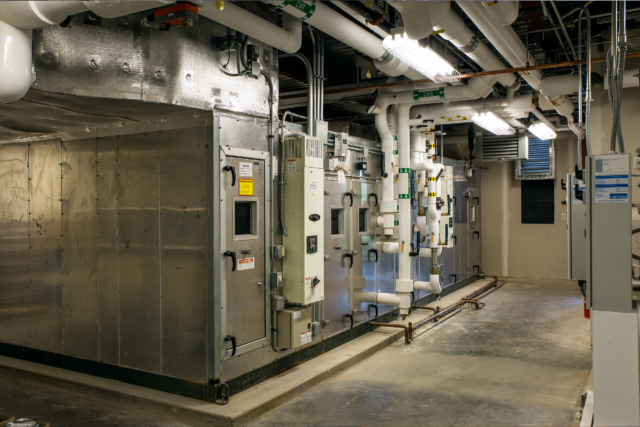Frequently Asked Questions: Ventilation Basics and COVID Impacts

Ventilation and filtration questions are still common as many districts evaluate short- and long-term solutions.
What is ventilation?
Per the New York State Mechanical Code (NYSMC), ventilation is defined as “the natural or mechanical process of supplying conditioned or unconditioned air to, or removing such air from, any space.” Ventilation air is the portion of supply air that comes from the outside (outdoors), plus any recirculated air that has been treated (filtered) to maintain the desired quality of air within a designated space.
How are buildings typically ventilated?
Ventilation can either be provided by mechanical means (fan, ductwork, grilles, etc) or by natural means (open windows, doors, non-powered roof ventilators, etc). The mechanical code recognizes and prescribes methods for designing both mechanical and natural ventilation systems; however, the New York State Education Department (NYSED) requires mechanical ventilation systems within all occupied areas of school buildings.
How are ventilation rates determined?
Ventilation rates are determined by code. In simple terms, ventilation rates for single zone spaces are calculated based on the number of people occupying a space combined with an area component of the same zone. Airflow per person and airflow per square foot vary for each space type. There are other factors, such as air distribution effectiveness and ventilation efficiency, that the code prescribes and ultimately affect the final design code minimum ventilation rate. Multiple spaces can be ventilated by the same system, and therefore the ventilation rate calculation is much more complex. Mechanical engineers are skilled at assessing code compliance and performing the necessary calculations.
Both state health and education departments have recommended ventilation rates be increased above code-required levels as much as possible. The CDC has published data indicating proper ventilation or increased ventilation within a space greatly reduces or dilutes the viral load and therefore transmission rate of the Sars-COV-2 virus. Natural ventilation systems (doors and windows) can be used if present. To increase ventilation mechanically, we must adjust outdoor air intake damper minimum positions within the HVAC air handling system equipment. A mechanical engineer should be consulted prior to adjusting existing HVAC systems, as any adjustments could adversely affect system performance and decrease occupant comfort to unreasonable levels.
What about filtration?
HVAC systems are required to have air filtration. Typically this is provided via a simple filter within the air stream to protect system heating/cooling coils and keep duct systems generally clean from dust and debris. Filters are rated with a Minimum Efficiency Reporting Value commonly known as the filter’s MERV rating. The higher the MERV rating, the better a filter performs. MERV ratings range from 1 to 16 with most existing school HVAC systems historically incorporating MERV 8 filters. MERV-13 is the recommended MERV rating by ASHRAE and the CDC as it is 85% effective at capturing the particle size of human respiratory droplets which carry the Sars-COV-2 virus. Replacing existing filters with higher rated MERV filters can therefore help reduce transmission of viruses like Sars-COV-2, but may also reduce airflow, increase fan energy, increase filter cost, and increase the filter replacement rate. Reducing the airflow of an existing unit could also inadvertently reduce the ventilation rate of the unit if it is not recalibrated accordingly.
As such, any proposed filter upgrade should be analyzed by a professional. LaBella can help analyze existing HVAC systems to determine if the systems have enough spare capacity to warrant a filter upgrade, discuss the pros and cons for doing so, or suggest other filtration systems such as in space air cleaners and HEPA filtration.
What about UV lighting or other similar air cleaning technologies?
Currently, NYSED does not allow ultraviolet (UV) lighting in any areas where occupants may be exposed to the UV light source due to the known risk of damage to eyes and skin. The only areas UV lighting can be deployed is within central system air handling equipment. These systems should be evaluated by a mechanical engineer or UV lighting vendor for applicability. Any new air cleaning technology utilizing Bipolar Ionization (BPI), or any other technology that can generate ozone or VOCs, is not recommended by NYSED or the NYDOH at this time.
Not sure where to start? Give us a call. School districts should first and foremost ensure that existing HVAC systems are well maintained and operating as originally designed. This includes ensuring that outdoor air ventilation rates are being maintained throughout occupied time periods. Districts can then work with LaBella to determine if making any system adjustments or filtration upgrades is feasible. If these upgrades are not feasible given existing equipment or control systems, than other methods of air cleaning or ventilating can be explored.